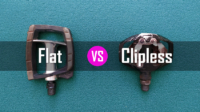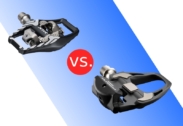Types of Bike Pedals — A Beginner’s Guide

Choosing the right bike pedals can be confusing for a beginner cyclist. There are various functions, shapes, and sizes to pick from, so having an idea of your riding style in advance will be helpful.
Finding the right pedals for you will help you enjoy your rides as much as possible. If you are an urban rider who uses your bike for running errands or visiting friends, then a simple platform pedal may be perfect.
If you enjoy long days on the trails or open roads, then a clipless pedal style will help you keep an efficient pedal stroke over long distances. This type of pedal saves you energy but can be tricky to get used to at the start. It’s worth noting that, sometimes, a new bike won’t come with any pedals. This means you will have to make your choice on the spot in a bike shop or on the online store, so knowing the basics is important.
In this article, we will cover the four main types of pedals, listing the best riding style for each, as well as some pros and cons.
Platform (Flat) Pedals

Image source: rei.com
These are the most common style of pedals out there. Often found on hybrids, commuter bikes, BMXs, and kid’s bikes. They are simply flat pieces of plastic or metal with no clips involved.
Beginners like this style of the pedal as their feet are free to move around while cycling. This is helpful in case there is the need to put a foot down quickly.
Clipless vs Flat Pedals: Is a Flat or Clipless Pedal Better for You?
The weight, durability, and grip of these pedals vary hugely. Well-made platforms are grippy in wet weather, sometimes using small metal spikes to maximize grip. These pedals are made from tough and lightweight metal alloys.
Poor quality plastic platform pedals will wear quickly and offer little grip. These can be dangerous to use in poor weather conditions as they become slippery.
It is also the least efficient pedal to use in terms of your pedal stroke. Find out more about pedaling and other cycling techniques.
- Good for beginners and easy to use
- Convenient and cheap
- Don’t require extra/specific shoes
- You won’t tip over (unlike what is possible with clipless pedals)
- Loss of power during the pedal stroke (inefficient)
- Can be slippery when wet
Cage/Toe Clip Pedals
Toe clip pedals are essentially the same as platform pedals, just with a toe cage on one side. They are another good option for beginners. They are easy to use and often double as a platform pedal on the side without the cage.
The clips themselves keep your foot in place and improve the efficiency of your pedal stroke, making them better for longer distances compared to platform pedals.
This type of pedal is a good choice for beginners who are not ready to advance to clipless pedals yet. The cages can be made from plastic, metal, or leather, and with or without fastening straps.
- Good for beginners and easy to use
- Don’t require extra specific shoes
- Inexpensive
- Improve pedal stroke efficiency compared to platform pedals
- Less efficient than clipless pedals
- Straps can wear quickly
- Straps can damage your shoes if tightened fully
Clipless MTB Pedals (Shimano SPD/Two-bolt)
This type of pedal allows for rapid clip-in and clip-out with specific MTB shoes.
These pedals are designed primarily for mountain biking but because the shoes are easier to walk in than road shoes, they are also excellent for any off-road use, bike touring, or leisure riding.
Shimano SPD vs. SPD-SL Pedals — Which Ones to Choose?
You clip into the pedal by pushing downwards when the receiver on the shoes is placed over the bolt. To clip out, you must turn your heel outwards releasing the lock.
This type of pedal/shoe combination allows you to maximize the efficiency of your pedal stroke with practice. They are also the most commonly used type when it comes to gravel bike pedals.
- Save energy and boost speed with the ability to maximize pedal stoke efficiency
- Easier to walk in than road clipless shoes
- Keep your feet secure and in the optimal position while navigating technical terrain
- Both the pedals and the specialized shoes needed are expensive
- Difficult to use at first, the possibility of tipping over if you don’t unclip in time
- Some pedals have limited compatibility
Clipless Road Pedals (Three-bolt)
Road-style clipless are designed specifically for road cycling, with limited functionality outside of this. The shoes are designed with stiff soles to maximize power transfer, making it easier to go for long distances.
The pedals function differently from mountain bike alternatives. The cleats require a platform that is connected using three screws to the sole of the shoe. This platform has a large surface area that also increases the ability to transfer power.
- Excellent power transfer, most energy-efficient pedal stroke
- Keeps your feet in the optimal position
- Lighter than SPD
- Easy to adjust cleat position
- Both the pedals and the specialized shoes needed are expensive
- The platform makes it challenging to walk in the shoes
- Difficult to use at first, the possibility of tipping over
Hybrid Pedals

These pedals combine MTB clipless on one side, with a platform on the reverse side.
They are an excellent choice for individuals making the transition to clipless, who would still like to be able to ride unclipped on some terrain. They also allow you to ride comfortably without your special shoes.
This style blends all the pros of MTB pedals with those of platforms, without the cons. The only thing is that you will still have to buy MTB-specific shoes if you want to use that side.
Frequently Asked Questions
Why are they called clipless pedals if you have to clip into them?
This is a common question that confuses most new clipless users. They are called so because they do not use toe clips or cages, which is confusing because you must clip in with these pedals.
Are clipless pedals bad for knees?
This is an ongoing debate that doesn’t have a definitive answer. Some people experience knee pain when switching to MTB or road clipless pedals from platforms.
This may be due to poorly positioned cleats, poor pedaling technique, or the cleats themselves.
If you experience pain after switching, you may need a professional bike fitting, or to switch back to the pedals you were using before.
Shop Bike Pedals on JensonUSA.com








I’ve been riding road and Fat Bikes for several years, relying on my nephew and friends and bike shops at time of sale to get me started. Did not want to show my naivety and ask.
Thanks